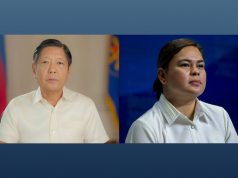President Rodrigo Duterte’s remark that he does not want the next ombudsman to be a woman has earned the ire of many is just the latest of a rather long list of anti-women comments he dropped publicly since he assumed the presidency in 2016.
On May 16, the president said that the next ombudsman “could not be [a] politician, especially not a woman.” Incumbent Ombudsman Conchita Carpio-Morales will retire on July 26.
Days later, a social media campaign called #BabaeAko and a collective statement from female leaders of various organizations went viral on social media as a way to express their dissent on improper acts exhibited by Duterte and other public officials.
Some even pointed out that three of the country’s highest officials—Duterte, House Speaker Pantaleon Alvarez and Senate President Vicente Sotto III—have all had a history of publicly dropping comments unfair to women.
Others theorized that Duterte may be afraid of women who fight back.
Maria Ressa, Glenda Gloria, Chay Hofilena & the other women of Rappler. Sereno. Conchita Carpio-Morales. De Lima. Leni. Risa Hontiveros. Agnes Callamard. The Duterte govt is attacking them bec, for all of Duterte's toxic masculinity, he is scared of strong and principled women.
— Bakla With A Cause ?️? (@jonasbagas) January 15, 2018
Unabashed
Duterte’s inappropriate comments have long been criticized for being misogynistic or sexist, but despite repeated public condemnation of such remarks, there seemed to be no letup.
According to a study titled “Patriarchy and Women’s Subordination in the Philippines” released in the 1990 issue of Review of Women’s Studies of the University of the Philippines Center for Women’s Studies, misogyny and sexism might not have been an issue among pre-colonial Filipino women.
Author Luz Lopez Rodriguez wrote that Filipino women back then enjoyed an esteemed status.
“Since the concept of private property still was to come with Spanish conquest, the concept of woman as property of a man had no social basis for existing,” Rodriguez wrote.
The author explained that the “historical process of colonialism, feudalism and capitalism” changed the role of women from co-equals of men into “objects of subjugation” from the Spanish era, which the Roman Catholic religion played a big part, to the spread of capitalism in the American period.
“Specifically, the subordinate position of Filipino women is the result of the merging of patriarchal and capitalist interests dominating the country,” Rodriguez wrote.
According to the 2008 National Demographic and Health Survey released by the Philippine Commission on Women “one in five women aged 15-49 has experienced physical violence since age 15 and 14.4 percent of married women have experienced physical abuse from their husbands.”
In March 2018, Sen. Risa Hontiveros revealed that there are at least two women in Manila who experience harassment in the forms of “acts of lasciviousness, sexual harassment, rape and violence.”
How women protect themselves
There are advocacy groups for women in the Philippines that promote women’s rights similar to the global #MeToo movement to end sexual violence, such as The Paper Project, I Can Serve Foundation and the Catcalled in the Philippines Facebook page.
In the political sphere, Hontiveros, Leila de Lima, Grace Poe, Vice President Leni Robredo, the Commission of Human Rights and the Gabriela party-list are among the most vocal critics against the president’s insensitivity towards women.
The rights of Filipino women are primarily protected by Republic Act 9710 or the Magna Carta of Women, which include leave benefits, government positions and equal access to education and training.
Laws that protect Filipino women against sexual harassment are the Anti-Violence against Women and Their Children Act, the Anti-Sexual Harassment Act of 1995 and Article 335 of the Revised Penal Code.










